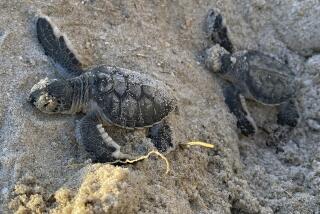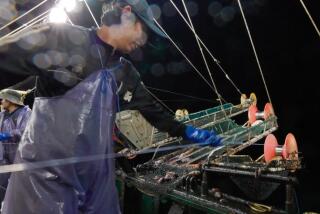Sea-Turtle Slaughter Spurs Protests : Mexico: Among the few survivors from the dinosaur age, environmentalists say the animals risk being snuffed out by the greatest predator of all: man.
- Share via
MEXICO CITY — A massive slaughter of endangered sea turtles by Mexican fishermen has aroused protests from environmentalists and put the Mexican government on the defensive.
Having overcome predators, climatic changes and other hazards for 150 million years, sea turtles are among the few survivors from the age of the dinosaurs. But now, environmentalists say, one of the world’s oldest animals risks being snuffed out by the greatest predator of all: man.
Not only are tens of thousands of sea turtles butchered annually for their skins in Mexico, but the eggs they lay on this country’s Pacific coast beaches are gathered up by the millions to be sold for their supposed aphrodisiac properties.
The biggest market for the skins is Japan, which turns them into shoes, purses, wallets and other accessories. Described by environmentalists as the world’s leading consumer of turtle products, Japan also buys from Mexico the illegally collected shell of the rare Hawksbill turtle for manufacture into articles ranging from tortoise-shell glasses to the decorative combs used by geishas.
Mexican environmentalists say the trade here is controlled by powerful interests that they liken to mafias. And contrary to the Mexican government’s claim that the turtles are an important food source, they say that tons of turtle meat stored in a state-operated processing plant has gone unsold.
“The money is in the skins, not the meat,” an American critic said. “They can’t even get rid of the meat they have stored.”
According to the Earth Island Institute, a San Francisco-based ecological group, “The present slaughter is the largest killing of an endangered species anywhere in the world.”
When President Carlos Salinas de Gortari visited London last month during a European tour, environmentalists there protested the killing of the ancient animals. Earlier this month, about 75 protesters, some wearing sea turtle costumes, demonstrated outside the Mexican Consulate in San Francisco.
Consul General Enrique Loaeza mollified them by announcing that Mexico has agreed to sign the Convention on International Trade in Endangered Species, known as CITES, which bans commerce in threatened fauna and flora. In Mexico City, a government spokesman said the accord, already signed by more than 100 nations including the United States, is still “under review” and could be signed sometime this year.
Loaeza also told the protesters that Mexico would ban the killing of all sea turtles by 1992, abolishing a “quota” that currently allows up to 20,000 of one species, the Olive Ridley, to be butchered annually in a government-approved slaughterhouse.
Mexican environmentalists warn, however, that 1992 may be too late to save the turtles. In any case, they say, the quota is routinely exceeded at the seaside slaughterhouse in Oaxaca state, and thousands more are killed by illegal “pirate” operations that pay bribes to Mexican government, navy and marine officials.
“It has come to the point that if the government does not cancel the quota and close the slaughterhouses, the turtles are going to disappear,” said Homero Aridjis, president of the Group of 100, a leading Mexican environmental organization.
According to a confidential document from the U.S. Fish and Wildlife Service, “the legal quota is used as a cover to ship excessive numbers of skins out of Mexico.” Ending it would eliminate any “legal excuse” for the trade and “would prevent Japan from importing Mexican skins, for it would then be contrary to Mexican law and in violation of Japan’s CITES obligations,” the document said.
Aridjis said that despite the 20,000-turtle quota, the officially approved kill had reached 35,000 by mid-December and was continuing. Including the turtles killed by pirate operations, the toll for 1989 exceeds 75,000, he said. In addition, an estimated 10 million eggs were scooped out of the sand illegally by poachers on government-protected beaches, Aridjis said.
Compounding the impact on the species, almost all of the sea turtles killed are adult females. Seven endangered species of sea turtle nest on Mexican beaches. But only the rarest, the Kemp’s Ridley, which roams the Gulf of Mexico, is now adequately protected under a joint U.S.-Mexican program.
On the Pacific side, environmentalists say, there is virtually no protection, and the slaughter is uncommonly cruel. Pirate fishermen often simply cut off the sea turtles’ flippers--for the skins--at sea, then throw them back into the water. Females are sometimes slit open for their womb eggs, a delicacy, and cast back to die a slow death. At the government-inspected slaughterhouse, turtles are killed with a .22-caliber gunshot to the head, but often they do not die immediately and are cut up while still alive.
“Too many people are trying to make a buck in the short term and don’t give a damn about the long term,” said a U.S. official who monitors the sea turtle problem.
He expressed gloom about the Mexican government’s willingness to truly protect the turtles.
More to Read
Sign up for Essential California
The most important California stories and recommendations in your inbox every morning.
You may occasionally receive promotional content from the Los Angeles Times.













